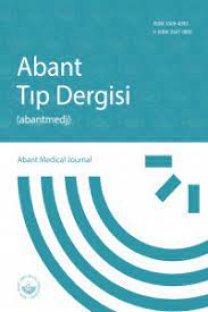Akromiyoklaviküler Eklem Dislokasyonunun Sentetik Bağ ile Tedavisinin Klinik Sonuçları
Akromiyoklaviküler Eklem, Dislokasyon, Sentetik Bağ
Clinical Outcomes in Treatment of Acromioclavicular Joint Dislocation by Synthetic Bonds
Acromioclavicular joint, Dislocation, Sentetik Bağ,
___
- 1. Kaplan LD, Flanigan DC, Norwig J, Jost P, Bradley J. Prevalence and variance of shoulder injuries in elite collegiate football players. Am J Sports Med. 2005;33(8):1142–1146. doi:10.1177/0363546505274718
- 2. Gastaud O, Raynier JL, Duparc F, et al. Reliability of radiographic measurements for acromioclavicular joint separations. Orthop Traumatol Surg Res. 2015;101(8 Suppl):S291–S295. doi:10.1016/j.otsr.2015.09.010
- 3. Mouhsine E, Garofalo R, Crevoisier X, Farron A. Grade I and II acromioclavicular dislocations: results of conservative treatment. J Shoulder Elbow Surg. 2003;12(6):599–602. doi:10.1016/s1058-2746(03)00215-5
- 4. Bradley JP, Elkousy H. Decision making: operative versus nonoperative treatment of acromioclavicular joint injuries. Clin Sports Med. 2003;22(2):277–290. doi:10.1016/s0278-5919(02)00098-4
- 5. Smith TO, Chester R, Pearse EO, Hing CB. Operative versus non-operative management following Rockwood grade III acromioclavicular separation: a meta-analysis of the current evidence base. J Orthop Traumatol. 2011;12(1):19–27. doi:10.1007/s10195-011-0127-1
- 6. Weaver JK, Dunn HK. Treatment of acromioclavicular injuries, especially complete acromioclavicular separation. J Bone Joint Surg Am. 1972;54(6):1187–1194.
- 7. Grutter PW, Petersen SA. Anatomical acromioclavicular ligament reconstruction: a biomechanical comparison of reconstructive techniques of the acromioclavicular joint. Am J Sports Med. 2005;33(11):1723–1728. doi:10.1177/0363546505275646
- 8. Michlitsch MG, Adamson GJ, Pink M, Estess A, Shankwiler JA, Lee TQ. Biomechanical comparison of a modified Weaver-Dunn and a free-tissue graft reconstruction of the acromioclavicular joint complex. Am J Sports Med. 2010;38(6):1196–1203. doi:10.1177/0363546509361160
- 9. Jones HP, Lemos MJ, Schepsis AA. Salvage of failed acromioclavicular joint reconstruction using autogenous semitendinosus tendon from the knee. Surgical technique and case report. Am J Sports Med. 2001;29(2):234–237. doi:10.1177/03635465010290022001
- 10. LaPrade RF, Hilger B. Coracoclavicular ligament reconstruction using a semitendinosus graft for failed acromioclavicular separation surgery. Arthroscopy. 2005;21(10):1277. doi:10.1016/j.arthro.2005.07.020
- 11. Thiel E, Mutnal A, Gilot GJ. Surgical outcome following arthroscopic fixation of acromioclavicular joint disruption with the tightrope device. Orthopedics. 2011;34(7):e267–e274. Published 2011 Jul 7. doi:10.3928/01477447-20110526-11
- 12. Jeon IH, Dewnany G, Hartley R, Neumann L, Wallace WA. Chronic acromioclavicular separation: the medium term results of coracoclavicular ligament reconstruction using braided polyester prosthetic ligament. Injury. 2007;38(11):1247–1253. doi:10.1016/j.injury.2007.05.019
- 13. Cohen G, Boyer P, Pujol N, Hamida Ferjani B, Massin P, Hardy P. Endoscopically assisted reconstruction of acute acromioclavicular joint dislocation using a synthetic ligament. Outcomes at 12 months. Orthop Traumatol Surg Res. 2011;97(2):145–151. doi:10.1016/j.otsr.2010.10.004
- 14. Wright J, Osarumwense D, Ismail F, Umebuani Y, Orakwe S. Stabilisation for the disrupted acromioclavicular joint using a braided polyester prosthetic ligament. J Orthop Surg (Hong Kong). 2015;23(2):223–228. doi:10.1177/230949901502300223
- 15. Vascellari A, Schiavetti S, Battistella G, Rebuzzi E, Coletti N. Clinical and radiological results after coracoclavicular ligament reconstruction for type III acromioclavicular joint dislocation using three different techniques. A retrospective study. Joints. 2015;3(2):54–61. Published 2015 Nov 3. doi:10.11138/jts/2015.3.2.054
- 16. Fauci F, Merolla G, Paladini P, Campi F, Porcellini G. Surgical treatment of chronic acromioclavicular dislocation with biologic graft vs synthetic ligament: a prospective randomized comparative study. J Orthop Traumatol. 2013;14(4):283–290. doi:10.1007/s10195-013-0242-2
- 17. Boldin C, Fankhauser F, Ratschek M, Haller-Schober EM. Foreign-body reaction after reconstruction of complete acromioclavicular dislocation using PDS augmentation. J Shoulder Elbow Surg. 2004;13(1):99–100. doi:10.1016/s1058-2746(03)00063-6
- 18. Stewart AM, Ahmad CS. Failure of acromioclavicular reconstruction using Gore-Tex graft due to aseptic foreign-body reaction and clavicle osteolysis: a case report. J Shoulder Elbow Surg. 2004;13(5):558–561. doi:10.1016/j.jse.2004.01.027
- 19. Mazzocca AD, Santangelo SA, Johnson ST, Rios CG, Dumonski ML, Arciero RA. A biomechanical evaluation of an anatomical coracoclavicular ligament reconstruction. Am J Sports Med. 2006;34(2):236–246. doi:10.1177/0363546505281795
- 20. Costic RS, Labriola JE, Rodosky MW, Debski RE. Biomechanical rationale for development of anatomical reconstructions of coracoclavicular ligaments after complete acromioclavicular joint dislocations. Am J Sports Med. 2004;32(8):1929–1936. doi:10.1177/0363546504264637
- 21. Debski RE, Parsons IM 4th, Woo SL, Fu FH. Effect of capsular injury on acromioclavicular joint mechanics. J Bone Joint Surg Am. 2001;83(9):1344–1351. doi:10.2106/00004623-200109000-00009
- Yayın Aralığı: 6
- Başlangıç: 2012
- Yayıncı: Bolu Abant İzzet Baysal Üniversitesi Tıp Fakültesi Dekanlığı
Fournier Gangreninde Cerrahi Tedavi Sonuçlarımız:Tek Merkez Deneyim
Serkan ERKAN, Hakan YABANOĞLU, Ramazan GÜNDOĞDU, Murat KUŞ
Osman YAKŞİ, Akif TURNA, Ezel ERSEN, Zeynep TURNA, Kamil KAYNAK
Gözden Kaçan Olgularda Kedi Tırmığı Hastalığı
Pinar SIRMATEL BUCUK, Asuman KİLİTCİ, Fatma SIRMATEL
Ferhat EKİNCİ, Atike Pinar ERDOĞAN, Ahmet DİRİCAN, Gamze GÖKSEL
4. Kuşak HIV ELISA Eşik Değerleri ile Doğrulama Test Sonuçlarının Birlikte Değerlendirilmesi
Emine TÜRKOĞLU, Sedef Zeliha ÖNER
Her Gerçek Umbilikal Kord Düğümlenmesi Acil Doğum Gerektirmez
Akne Vulgarisli Gebelerde A Vitamini Düzeyi ve Vücut Kitle İndeksinin İncelenmesi
Özgül ÖZGAN ÇELİKEL, Emine UNAL, Özlem DOĞAN, Nurkan AKSOY
Hemşire Akademisyenlerde Müziğin Anksiyete ve Kaygı Düzeyine Etkisi: Randomize Kontrollü Çalışma
Gürcan ŞİMŞEK, Mehmet Eşref ULUTAŞ, Alpaslan ŞAHİN, Kemal ARSLAN
